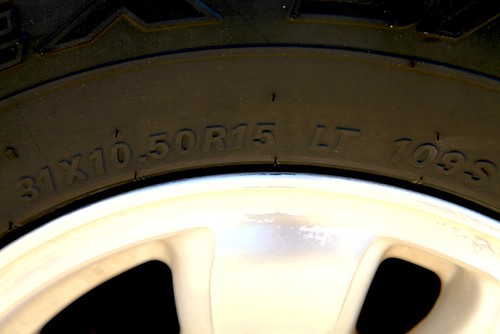Tire pressure
 The load index 109, on the right, is used with the load range to calculate optimum pressure.
The load index 109, on the right, is used with the load range to calculate optimum pressure.
A reader, Christian, sent in this comment to my recent post The physics of tires and lifts:
I have a related question that might warrant its own post. Is there a formula for finding your optimum tire pressure? Sounds simple enough. Most “experts” just say to check the owner’s manual. I’m skeptical because my new F150 has a front/rear weight ratio of 60/40, yet Ford recommends a higher pressure in the rear (60 rear, 55 front). I'm assuming this is in anticipation of a full payload but it seems to me that the correct pressures should be based on actual axle loads and tire volumes (i.e. a larger, wider tire will need lower pressures but the front/rear ratio should remain the same). Off-road pressures will be much lower (and highly variable) but again should utilize the same front/rear ratio. Does this sound right?
Christian, common sense is leading you in the right direction.
Tire pressures recommended by vehicle (and tire) manufacturers have varied significantly over time, often depending more on what they perceived as their customers’ priorities than on efficiency or even safety. In the days of Ford Galaxies and Buick Rivieras (and 32 cents-per-gallon gas), it was all about ride comfort, and recommended tire pressures hovered in the 20s. Today, fuel efficiency is the name of the game, and pressures are much higher, as you found on your F150. However, as you noted, the manufacturer invariably lists only a single figure. Especially in the case of a pickup, loads are likely to vary tremendously. Proper pressure for a light load will be inadequate for a heavy load, and proper pressure for a heavy load will be excessive for a light load and will cause premature tread wear in addition to a bouncy ride.
There are a couple of good ways to determine proper tire pressures for your vehicle to compensate for varying loads. First is an inflation/load chart. Why these aren’t front and center on all tire company websites I have no idea—most specification charts list only maximum load—but if you search deeply enough you can find them. We’ve posted one used by Discount Tire HERE.
An inflation/load chart uses the load index listed on the tire’s sidewall (after the sizing information), and the load range (C, D, E, etc.) to determine an optimum pressure. Much better than a single figure, obviously. To exploit this information fully, however, you need to know how much weight is on each tire. You can calculate that closely by finding a commercial scale the weighing each end of your vehicle, then dividing each by two. If you have a slide-in camper you remove for commuting in between trips, you can either make two trips to the scale or calculate the added mass of the camper if you know its dry weight. With that information in hand, you can cross-reference the chart to arrive at a very useful figure.
A simpler way to determine optimum tire pressure (as well as to double-check the chart method) is by “chalking.” Use a piece of bright chalk to mark a thick line directly across the tread of each tire. Drive a few hundred yards on pavement (preferably in a straight line) and look at the line. If it is wearing off evenly, your tires are correctly inflated, as the tread is bearing the load uniformly across its width. If the center of the line wears off more quickly the tire is overinflated, and if the edges wear off first it is underinflated. You might have to use paint rather than chalk to ensure the line doesn’t wear off too quickly.
Both these methods are designed to calculate road pressures. Once you have them figured, you can use them to arrive at starting points for airing down on off-pavement routes. A 30 to 40-percent reduction in pressure is usually enough to lengthen the tire’s footprint effectively, increasing traction and reducing impact on the trail as well as attenuating bounce over washboard and rocks. For deep sand one would drop quite a bit more than that, of course.
This might seem like more trouble than it’s worth to some. But you only need to do the weighing once per vehicle, and then recalculate if you buy different tires. But maintaining ideal tire pressures—as opposed even to just adequate—will significantly increase tread life, in addition to enhancing every aspect of tire performance.
